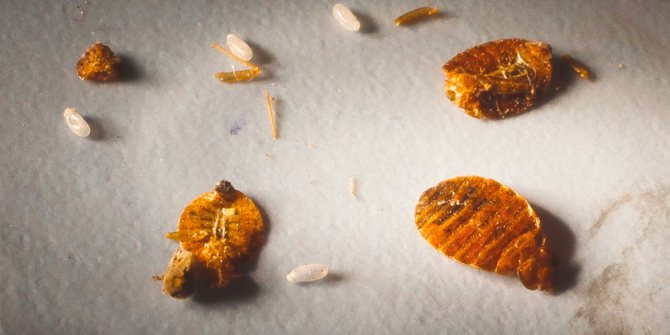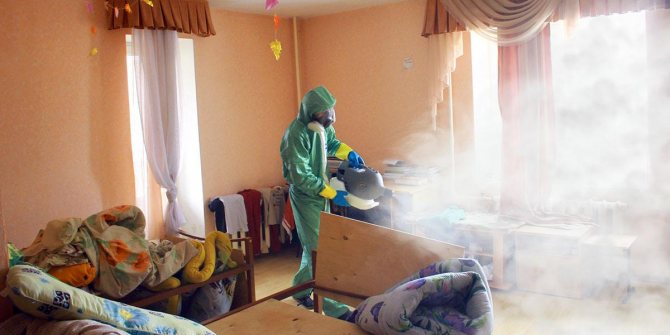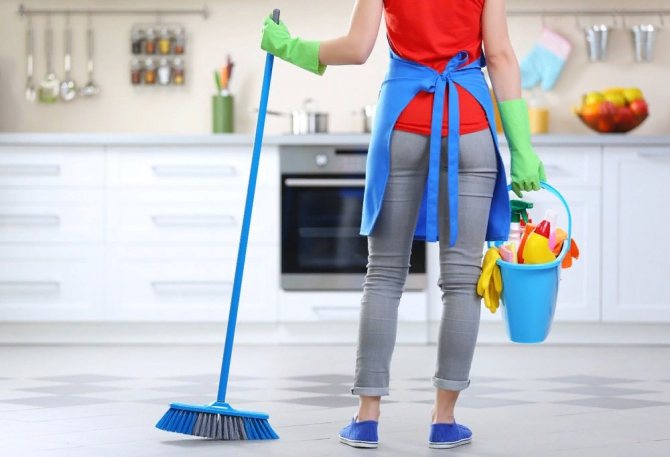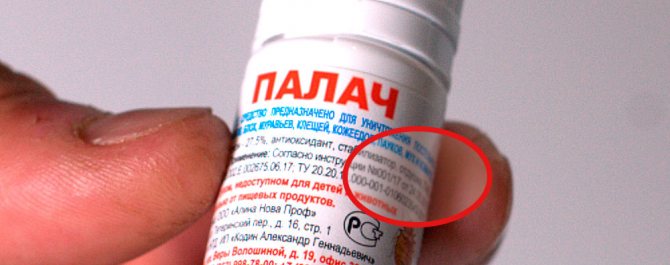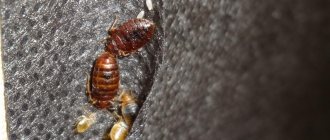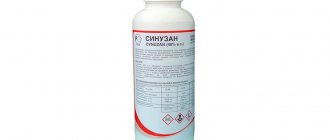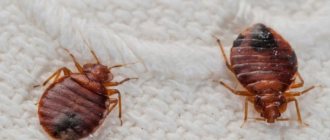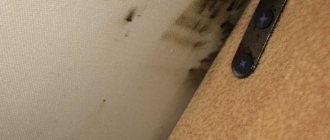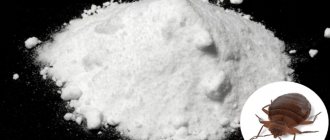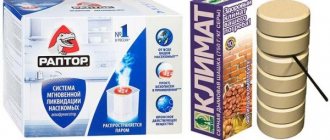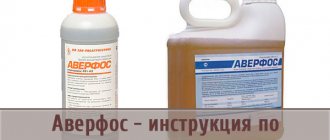
Sanitation of bedbugs by SES employees is perhaps one of the most reliable ways to get rid of parasites in a room. However, before you call the Sanitary and Epidemiological Station for baiting bedbugs, you should take into account some important nuances ...
- Today it is customary to call the word "SES" or "Sanitary and Epidemiological Station" any offices that are engaged in the destruction of bedbugs, cockroaches, rats or fleas. Some of these companies call themselves SES with a prefix of their own name: for example, SES Clean City, SES SanEpidemStation. This is somewhat misleading people who are not knowledgeable in these matters. Generally speaking, SES is a state institution that is part of the Rospotrebnadzor itself. It is about this Sanitary and Epidemiological Station that we will continue to talk, describing the work and the means used for sanitation.


- Considering that the SES is a state organization, before contacting it, you should be ready to interact with the harsh bureaucratic machine. And although the situation has been improving a little recently, however, the Sanitary and Epidemiological Stations have not yet reached the level of high-quality customer-oriented service in most cities.
- The presence of bedbugs in the apartment is not a critical epidemiological problem, and therefore the appropriate calls of inspectors and pest controllers for the purpose of sanitation are not a priority for the SES.
However, there is good news: in the house in which the Sanitary and Epidemiological Station specialists worked, bedbugs in most cases disappear for a long time, or even forever. Therefore, when choosing who to entrust the destruction of bedbugs in your apartment, sanitation by the SES forces should be remembered first of all.
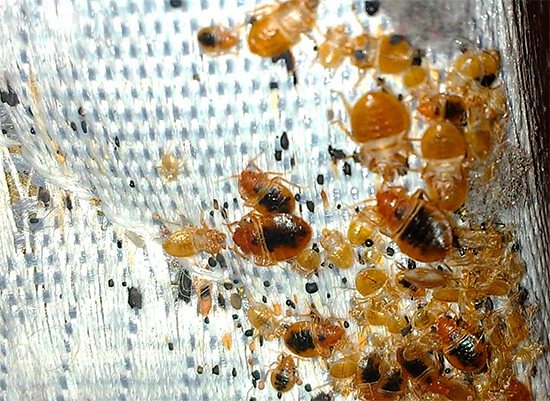

How do bed bugs behave after sanitation?
Professional baiting of bedbugs by SES services is the most effective method for destroying domestic ectoparasites. Self-deliverance is rarely successful. The ubiquitous pests settle in various non-obvious and inaccessible places. Even after etching 99% of the population, the chances of its re-recovery are real. In addition, the remaining individuals will develop immunity to the pesticide, and it will become more difficult to get rid of them.
One way or another, you will have to seek help from professional disinfectants. The service comes to the place, inspects the apartment and carries out processing. Experts explain how the bugs behave after disinfection, what is the norm and how long they die.
The behavior of bedbugs is largely determined by the type of poison used. According to the mechanism of action, several categories of insecticides are distinguished:
- contact (Yuraks, Averfos) - they act through the chitinous integuments of arthropods, gradually penetrating inside and poisoning the body;
- intestinal - "work" after entering the intestines;
- contact-intestinal (Sinusan) - act through two ways of penetration.
Contact insecticides are used against bedbugs, since ectoparasites feed exclusively on human blood and are not interested in other food.
After what time the bugs die, it also depends on the pesticide group:
- Pyrethroids. They act on nerve endings, leading to paralysis and death. Upon contact with pyrethroids, the death of the pest does not occur immediately, but within several days.
- Organophosphate compounds.They act through the digestive system - the poison blocks the production of enzymes necessary for the digestion of extracted food. From the moment of meeting with the poison, ectoparasites die every other day.
After disinsection, bloodsuckers come into contact with an insecticide - irreversible processes in the body begin. Some die quickly, others return to the nests and manage to infect the remaining bugs.
What to do with clothes, toys and utensils?
After the baiting of bedbugs, individual things and objects in the room are either washed or not touched at all.
So, clothes that were directly in open places and on which the drug got into should be washed or at least rinsed in water so that the smell of the product does not remain on it.
Clothes that were in closed cabinets during processing do not require washing - the drug did not get on it (we usually do not process cabinets, except for the most egregious cases of infection).
We recommend hiding children's toys in bags before processing and do not process them. Bedbugs almost never settle in them, and it is very difficult to wash them after processing. The same toys that have been treated with the product can be washed in the washing machine - if their filler does not lose its structure after that, then it will be quite possible to play with them.
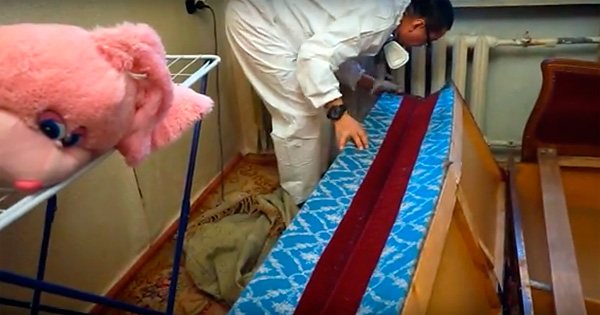

In soft toys, bugs almost never settle, and if there are single individuals here, they die when processed and sprayed on the toy.
Dishes in closed cabinets in the kitchen usually do not undergo any processing, because, firstly, bugs usually do not settle in kitchens and processing is not carried out here, and secondly, in closed cabinets, the agent does not get on it. Nevertheless, if the treatment was carried out in all rooms and even in the kitchen, especially with hot fog (which penetrates even the narrowest cracks), it is advisable to wash the dishes after it with plain clean warm water.
How to prepare an apartment
Sometimes we do not even suspect that the smallest microorganisms and insects live in our neighborhood. More often than not, we coexist independently of each other, and this is normal - the law of nature. But insects such as bedbugs or cockroaches make life unbearable over time. If there are too many bedbugs, self-treatment with chemicals is likely to be useless. Professional disinfection (or disinsection) will help to cope with the problem, in other words, the treatment of an apartment from bedbugs.
It is better to take food, drinks, personal hygiene products out of the apartment in order to avoid splashes of chemical devices on them. During the disinfection of the apartment from bedbugs, first of all, the sleeping place is processed: the bed itself, pillows, the place under the bed, the corners of the apartment, the baseboard, so it is important to provide free access here.
Desinsection must be carried out in the most thorough manner. If at least one pregnant female survives, the process of parasite infestation will repeat over and over again. Therefore, see for yourself how carefully the specialist treats the beds and the room.
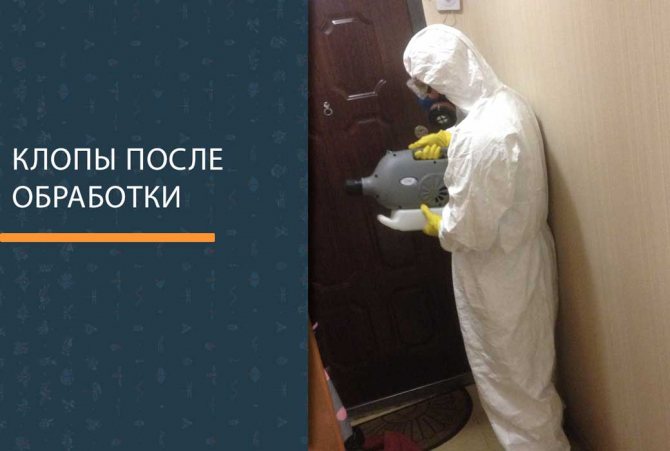

The disinfestation process for bedbugs usually lasts no longer than an hour. Then the owners will need to leave the apartment for a couple of hours, then thoroughly check the apartment, wash bed linen and clothes at a temperature of at least 90 degrees. Bedbugs cannot stand temperatures above 45 degrees, they simply die.
After treating the apartment from bedbugs, collect dead insects, larvae and eggs in a trash bag. After disinfestation, it is advisable not to carry out wet cleaning for as long as possible. It is best to go to the country house or to visit relatives for a week or two. The fact is that the bugs that have hidden in secluded corners, the surviving bugs will die already when moving along the treated surfaces.
You will need a complete wet cleaning of the room.Thoroughly it is recommended to wash the dishes, wipe the furniture with hot water and an antiseptic (for example, soda solution). It is imperative to thoroughly ventilate the premises. Vacuum hard-to-reach places: corners, baseboards, furniture.
After disinfection (disinsection), the bugs disappear completely either for 2-3 days, or after a week. Do not be surprised if at first you notice parasites slowly moving around the apartment - this is a good sign. The process has begun! It is good when the company gives a guarantee for processing. In case of failure, processing can be repeated and completely free of charge.
On the websites of some companies involved in the disinfection of premises, it is indicated that the bugs will completely disappear in a month (quite a long time), so during this time it is useless to swear and complain. It is better to discuss all the details and subtleties of the work of any particular company personally.
Discuss joint disinfection with your neighbors, because it may well happen that cunning parasites will migrate to them after chemical treatment.
Often, after a bug attack on an apartment, you have to throw out pieces of furniture. mattresses, pillows. The damage caused by the parasites is significant and the cost is high.
The appearance of bedbugs in an apartment is a real test even for a person with nerves of steel. The bites of these small insects make you forget about good rest: the victim often turns over in his sleep, and wakes up in the morning with painful "paths" on his body. Where bugs can come from in an apartment, read here.
It is not always possible to kill bedbugs in an apartment on your own: it is not so easy to find all the nests of bloodsuckers. This is the main danger: bugs reproduce extremely quickly, turning into sexually mature individuals in just 40 days. Therefore, professional destruction of bedbugs is the most reasonable way out of this situation.
Disinsection from bedbugs is a set of measures to eliminate pests, during which the room is sanitized with insecticides. The drugs used during disinsection work are not dangerous to humans, but deadly to parasites. Temperature destruction of bedbugs (hot and cold fog) is also called pest control.
Disinfection of an apartment from bedbugs differs from baiting cockroaches or ants. Bloodsucking, as the name suggests, feed exclusively on the blood of mammals and birds. Bedbugs will not be interested in poisoned baits intended for cockroaches, for the reason that bloodsuckers are unable to digest anything but blood.
The Bed Bug Control Service uses several methods to eliminate insects:
- insecticidal effect;
- freezing of pests;
- heating surfaces where bedbugs live.
Spraying insecticides in an apartment is the most difficult, but the most effective way to get rid of uninvited guests. Usually city SPPs prefer to use this method. For information on how to deal with bedbugs on your own, read the article "Treatment for bedbugs using purchased drugs and folk remedies."
All exterminators of our service leave a reminder to clients about what to do after treating the apartment from bedbugs, how to clean up here and what to do with things, furniture and food.
In general, after disinfestation in the apartment you need:
- Maintain it completely closed for a strictly defined period, the duration of which depends on the processing method;
- Ventilate the apartment for at least an hour with a through air flow;
- Wipe the surfaces with which people and pets come into contact most often with a soap and soda solution;
- Rinse or wash clothes, wash dishes that have been left uncovered.
It is not recommended to carry out general wet cleaning immediately after processing.In most cases, the optimal period for its implementation is 5-6 days after pest control, when it is absolutely possible to be sure that there are no bugs left in the room.
Immediately after processing and airing the apartment, you do not need to wash it, since in this case the effectiveness of the product will decrease and some of the bugs can survive.
After disinfection, keeping the room for several hours and thoroughly ventilating it, you can return to the apartment, you can sleep in it, eat, and carry out normal life activities. Children and all pets can be returned to it. The very same infusion and airing should be carried out taking into account some specifics.
Immediately after processing in the apartment, you need to close the windows, doors and, preferably, the ventilation holes so that it is infused, and the insecticidal preparation does not disappear, but the donkey settles on all surfaces and penetrates into various cracks and holes in which bedbugs may be.
Of course, with such insistence, neither people nor pets should be in the room.
The timing of such a maintenance of the apartment:
- 3 hours if applied by cold fog or hand spray;
- 6 hours, if the destruction of bedbugs was carried out using hot fog or a complex. In this case, the residence time of the apartment is longer, since when using hot fog, the aerosol particles are smaller and stay in the air longer, and settle on the surface more slowly.
We suggest that you familiarize yourself with: How to find a den of cockroaches in an apartment
If the treatment with hot fog was carried out in the morning, you should return to the apartment in the evening. If the work was carried out in the afternoon or in the evening, then it is advisable to close the premises for the whole night and return to it in the morning. On the very first night after treatment, you can sleep in the apartment (including on treated beds and sofas) without fear for your health.
The first thing to do after returning is to ventilate the apartment.


After proper ventilation, people (including children of any age) and pets can be in the room. When airborne, insecticide is drawn out into the ventilation or outside, and deposited on surfaces dries up and no longer poses a danger to humans.
You need to ventilate the apartment for at least 1 hour. If the persecution was carried out in the warm season, it is advisable to weather the room and take longer - up to 2-3 hours. This will be a guarantee of safety for people and pets.
You do not need to be in the apartment during airing. It is enough just to open wide the windows and doors, remove the damper from the ventilation and go out into the street or into the entrance.
Treatment of the premises after disinfestation should be minimal and very limited. This requirement is explained by the fact that in the apartment it is necessary to leave as much of the dry preparation as possible, which has settled on the surfaces. In this case, the surviving bugs during the treatment will get out of the shelters, move along the surfaces covered with a layer of the agent, stain in the preparation and poison themselves.
Young larvae can hatch from the eggs laid before processing, and therefore a layer of the preparation must be preserved on the surfaces so that this "young growth" is etched in the very first days after birth.
The more the drug is on the surfaces and the stronger the parasites get dirty in it, the higher the likelihood that they will all die and repeated disinfestation will not be required.
Therefore, after airing the apartment, you only need to wipe the individual surfaces with which people and pets most often come into contact:
- Kitchen table;
- Doorknobs;
- Cranes;
- The surfaces of the bedside tables;
- Toilet bowls;
- Sinks.
They should be wiped with a soap and soda solution, the soda in which effectively neutralizes the active ingredients of insecticidal agents. Also, any detergent can be used for this purpose.
All other surfaces are best left untouched.If there is a very strong fear of the drug, it is enough to wipe the floor in the room where children or pets often play. In this case, be sure to leave the floors unwashed along the baseboards, under beds and sofas, under cabinets - where bugs move most often.
After treatment with both cold and hot fog, no stains and streaks remain on the floors or furniture, and therefore there is no urgent need to wash them out.
In general, you should not be afraid that after airing the room with a remedy, someone will be poisoned here. In our practice, for 12 years of effective treatments and the use of powerful agents, there have never been such cases of poisoning. Still, the layer of the drug that forms on the surfaces is very thin, there is little money here.
Can you sleep on treated sofas and beds?
All sleeping places - sofas, beds, mattresses - after processing, you can sleep without any additional measures. You can, if you wish, lay 2-3 sheets on them, wrap the treated pillows in 2-3 pillowcases, but in general there is no need for this: the drug absorbed into the upholstery does not enter the air and does not penetrate into the respiratory tract of a person.
Moreover, you need to sleep on treated beds. If there are surviving bugs in the room, they will tend to get close to the sleeping person at night, and therefore will crawl both on the bed and on the mattresses. Here they will come into contact with dried insecticide particles and sooner or later they will be poisoned. If a person does not sleep on the bed, insects will not climb here and the likelihood of their death will be less.
Duvet covers and sheets that people sleep on and that have been treated with the product should be washed and dried. There are no bedbugs on them, but they can retain the smell of the insecticide.
All this is true for ordinary beds and sofas, and for cots. A child can sleep safely on a clean sheet and a clean pillowcase, covered with a blanket in a clean duvet cover, even if there is a treated mattress underneath.
What to do upon returning home after treatment for bedbugs?
Do not relax after the departure of the professionals. The owners should clean the apartment and ventilate it well. In addition, you should clean dishes and electronics that may come into contact with food. To clean the devices as much as possible, you need to use products with alkali.
After treating bedbugs, on this day, you should refrain from wet cleaning the floor. Moisture will wash away the preparation applied by the master. It is necessary to wash the floor without touching the baseboard after 48 hours. It is after this much time that adults die. After disinfection of the house from bedbugs, the furnishings are also wet-treated.
Worth knowing! There is no need to wipe sofas, armchairs and their skeletons. These are the armrests, rear backrests and lower rails.
An insecticide applied to furniture is a preventive measure against bedbugs. For ceilings, walls and baseboards, it is best to use a powerful vacuum cleaner. He is able to remove dead parasites, their eggs and larvae (more about them here). After this procedure, it is recommended to discard the dust bag.
After the visit of the sanitary officers, the owners should:
- Close windows, doors, ventilation ducts.
- Leave the room for 3-6 hours (depending on the type of drug). At this time, the bugs will crawl out of secluded places and come into contact with the insecticide. If the treatment was carried out in the evening, it is better to spend the night in another place.
- Open windows and provide air flow into the room. Make a draft. Airing should last an hour (at least).
- Hard surfaces that people and pets are forced to come into contact with should be treated with an aqueous solution of soda (100 grams) and laundry soap (30 grams).Take 1 liter of water.
- Wet cleaning is possible only after a week. Within 7 days, single insects that did not die immediately will move around the apartment. The insecticide that has dried, but not wiped off, will continue to work.
- General cleaning with thorough washing of skirting boards and other surfaces in hard-to-reach places is done after 20 days. All this time, the insecticide will act and will not allow new bugs from the larvae to appear.
If you are in doubt about what you can and cannot do after disinfection, it is better to call the specialists.
Sometimes, after processing the SES, residents again find new bites of domestic bugs and traces of parasites. In most cases, do not panic - most likely, in two weeks the attacks of the bloodsuckers will stop.
If after a month the bugs continue to bite, then there is a possibility that the measures for the destruction of bloodsuckers were carried out with errors. Moreover, non-compliance with the technology is possible both on the part of the disinsection service and the residents themselves.
Likely reasons why bedbugs remained after processing the apartment:
- Poor preparation of the premises. A large pile of things prevents the spread of bed bug repellent. You need to take out unnecessary items from the apartment, put clothes in the closet, food in the refrigerator, and move furniture away from the walls. Beds and sleeping sofas must be laid out, all drawers must be opened.
- An error when choosing a drug. If after the first treatment the bugs have not gone away, there is a possibility that the ectoparasites are already immune to the poison used. To prevent such a situation, disinfectants should be given full information about previous attempts at self-control and the names of applicable repellents.
- Wrong actions after grass bed bugs. The most likely reason is the haste of general cleaning. The process of death of the bug population is delayed for a couple of weeks, so the insecticide must still remain indoors at this time.
- Psychological factor. Sensitive individuals, even after a well-performed disinfection, continues to feel that the bugs do not disappear and bite even more strongly. This is a consequence of the nervous tension suffered earlier. In some cases, bedbug bites do not go away for a long time, inflamed wounds cause discomfort, add "illusions" of the presence of parasites.
Important! To expel bed bugs, the Sanitary and Epidemiological Station uses moderately toxic agents of the third or fourth hazard class. Aggressive pesticides are replaced with microencapsulated drugs of prolonged action - the components are active for up to two months.
If after 1.5-2 months the pests continue to crawl, you should contact the disinfection service for explanations. Experts will ask about the actions of the apartment owners after the refurbishment and find out the reason why the bugs remained after the treatment.
It is possible that new individuals migrated from neighbors or were introduced from the outside. In these situations, re-treatment will be required - it is advisable to disinfect the adjacent apartments as well.
Reviews after disinfection will help to understand the question of how long arthropods die and what to do if bed bugs reappear a month later.
Turning to professionals for help in the fight against bloodsuckers is the best solution. Employees of the disinfection service will select an effective insecticide, treatment tactics and actions after sanitation. Compliance with all the recommendations will allow you to expel the annoying population in a short time.
We suggest you familiarize yourself with: When to mow the lawn for the first time after planting
Turn on / off navigation
- Rates
- Bedbugs
- Mosquitoes
- Cockroaches
- Rodents
- Legal entity
- Insects
- Contacts
Why are bedbugs started and where to look for them?
To get rid of bed bugs, you first need to find them. As a refuge, these parasites choose:
- mattress;
- bed frame;
- sofa;
- space under the skirting boards;
- cracks in the walls;
- places where wallpaper or linoleum does not fit tightly;
- sockets;
- cabinets;
- paintings;
- carpets;
- window frames and window sills;
- soft toys and many others. dr.
By the way, there are many reasons why bedbugs appeared in the house. However, most often parasites come from neighboring premises. They easily pass through the narrowest slots. In addition, if you have pets that go outside, then they can also bring these blood-sucking insects.
You can also "pick up" a bug while spending the night in another place, and then returning home to your bed. This parasite easily hides in clothing where it is difficult to spot. Finally, when purchasing used furniture, you can also bring bedbugs into the house. So no one is immune from the appearance of these pests.
How to remove the smell after pest control?
An unpleasant consequence of any disinfestation treatment is the smell. The scent of chemicals can persist indoors for days or even weeks. The most difficult thing is to remove the pungent smell from upholstered furniture sets, armchairs, mattresses.
How to get rid of extraneous odors and restore freshness to the room:
- After returning home, you need to open the windows to overtake and weather the apartment as long as possible.
- For the period of action of the insecticide, it is necessary to leave the house more often and arrange through ventilation.
- How to remove odor from furniture? After two to three weeks, it is advisable to wash the covers from cushions and mattresses. If the smell persists after washing, you can resort to aromatic detergents or hang the textiles outside.
- Clean carpets periodically with a vacuum cleaner.
The main thing that needs to be done to eliminate the insecticidal odor as soon as possible is to increase the air exchange rate in the room. If it is not possible to arrange a draft, it is enough to open a window and turn on the forced exhaust ventilation.
Some pesticides have a very persistent aroma. Not everyone is ready to wait for how long Karbofos disappears, as it retains its smell for up to several weeks.
To quickly get rid of the stench, you can call a cleaning company. Firms offer ozone cleaning. Processing allows you to quickly eliminate extraneous odors, and at the same time to destroy many viruses and bacteria.
High penetrating power ensures effective removal of odors from pile surfaces and sofa cavities. Ozonation does not mask chemical odors, but destroys them at the molecular level.
In families with small children or allergy sufferers, it is better to poison the parasites with odorless insecticides, such as Confidant.
When the processing of the premises is completed, the owners breathe a sigh of relief. But the joy is darkened if the bugs bite the residents after pest control, as before. Why is this happening?
It happens that the owners, due to carelessness or negligence, ignore the recommendations of specialists. On the day when they were supposed to receive a portion of the poison of the bugs after processing the SES, the residents begin a thorough cleaning. As a result, the active substance is washed off. Therefore, the surviving insects will continue to bite, and new ones will be added from the surviving larvae.
It takes time for the chemical to evenly spread throughout the entire space of the housing:
- After pest control using the hot fog method, the apartment should “stand” with the windows and balcony doors closed for up to six hours.
- If a sprayer or cold fog was used to kill insects, it is required to leave the housing closed for three hours.
If the owners decide to open windows or doors ahead of time, some of the insecticide may disappear.
Three days after treatment, it is recommended to vacuum the sofas, armchairs, wall surfaces. As a result of such actions, the larvae will be destroyed and the dead adult bugs will be removed. Otherwise, there is a risk that harmful insects will continue to multiply.
Yaroslavskoe shosse, 9, building 4 129337 Russia, Moscow 7 (495) 641-82-15
After carrying out pest control measures, many citizens begin to complain that the bugs have not disappeared and continue to cause trouble. Very often this is due to the fact that after processing all the rules were not followed and the insects or their larvae remained alive.
What should be done after pest control, you probably ask. The answer from the professionals will definitely suit you:
- It is better to ventilate the apartment after a few hours. After processing, close it and take a walk in the fresh air - let the parasites breathe in plenty of poison.
- After a couple of hours have passed, start cleaning. Wash all dishes with baking soda, wipe all exposed surfaces with a damp cloth and vacuum upholstered furniture, floors, walls, baseboards. This is done in order to remove dead insects and their larvae.
- Wash all clothing, linen, curtains in hot water. The water temperature must be at least 80 0 Celsius. It is best to boil bed linen and towels.
- Soft toys, shoes, fur coats can be held over the steam, and then dried in the fresh air.
- Do not forget to wipe all the handles in the apartment.
- To be on the safe side, always wash your hands with soap and water at first.
If you do not want insects to reappear in the apartment, then after processing, you should not enter the apartment for three hours. It is not recommended to wash the floors earlier than two to three days after treatment. Old people, children and pets (cats and dogs) should not be allowed into the room until 3 hours after treatment.
Correct adherence to these guidelines will allow you to start a quiet life. After 2-3 months, it is advisable to repair the room, remove the old wallpaper, seal all the cracks and small holes in the floor and baseboards. You can restore old upholstered furniture and carefully carry out regular inspections of the premises in places where bedbugs may appear. This is best seen when examining bed linen, which may show blood stains.
Observe all hygienic requirements, do wet cleaning, coming from trips, carefully inspect the things that you bring in your suitcase. All these security measures will help you prevent unwanted "tenants" from appearing in your apartment and will save you from the need to use the services of pest control specialists.
Order a pest control service
rodent dietary preferences
best bait spots
the most effective drug for the destruction of parasites
If the treatment has already taken place, then the most important thing for you will be to find out how to get rid of the smell after the destruction of bedbugs. To answer this question, let's remember from the school chemistry course what the smell is. Smell is the smallest particles of matter carried by air currents. That is, if your apartment was treated with a chemical insecticide of the first or second class of danger, this poses a serious threat to the health of all people living in the apartment, since particles of a life-threatening insecticide constantly enter your respiratory tract and the only possible option to get rid of this harmful effect is neutralization of this substance by chemical means.
During
carrying out a procedure to remove odors
apartment surfaces are treated with special reagents
neutralizing odor sources (including chemicals)
and splitting them into simpler volatile compounds that do not carry any harm to living people.
The most effective odor removal method in this case is dry mist treatment using a special generator. Only a specially trained person using a dry fog generator and a special liquid - a bioactivator can carry out such a procedure correctly and effectively.
This issue is relevant for residents if the apartment has been treated with domestic agents for the destruction of bedbugs and a persistent unpleasant odor has remained.
If you are faced with the problem of a strong unpleasant odor that arose after the treatment of the apartment from insects, the most correct solution would be to contact the professionals. One of the specializations of our company is the removal of unpleasant odors arising after disinfestation treatment. You can get a free consultation on the removal of odors by phone (812) 927 58 69 or order this service using the contact form on the website
If the smell after the destruction of bedbugs is not very strong and you decide to fight it yourself, you can follow the tips below that we have prepared for you.
Here are some tips to tell you
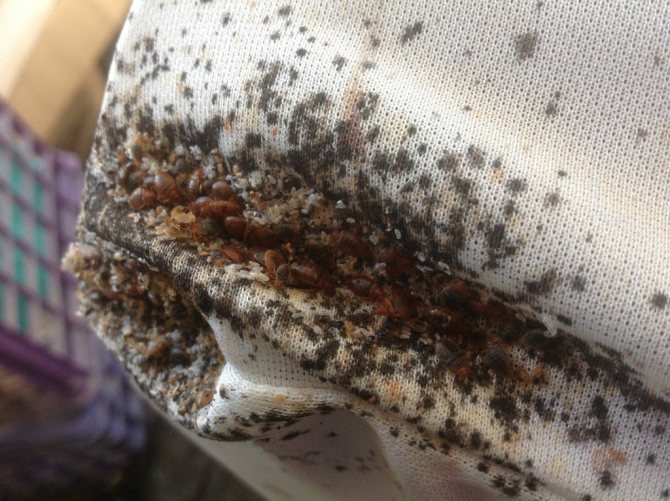

... When the procedure has already been carried out, get ready to thoroughly process the room in three stages.
- The first stage is wet cleaning, which, moreover, can prevent the possibility of poisoning. True, you only need to wipe with a damp cloth only furniture, surfaces of tables, chests of drawers, cabinets, and so on, while it is better to leave baseboards and floor coverings intact for a period of up to 1 month. This is how long it will take you to understand that the bugs have disappeared from your apartment forever.
- Second phase. It is important to ventilate the room, wash the dishes, and wipe the door handles. The textiles should also be washed, this applies to all furniture covers, curtains, bedspreads, pillows and blankets.
- The third stage. You shouldn't forget about furniture either, although things are more complicated with it. Use scented cleaners to remove odors from mattresses and sofas, or take furniture out onto the balcony to ventilate. True, it may take a couple of months for complete ventilation.
We suggest that you familiarize yourself with: Where can a mole start in an apartment
If that doesn't help, call us and order a deodorizing service. A specialist will come to your home and treat the apartment with a special compound that neutralizes not only the smell but also its source, as well as the harmful effects of chemicals on your health. The apartment will now smell nice for a long time, and you can get rid of the smell after destroying bedbugs forever.
Professional handling Post-treatment cleaning
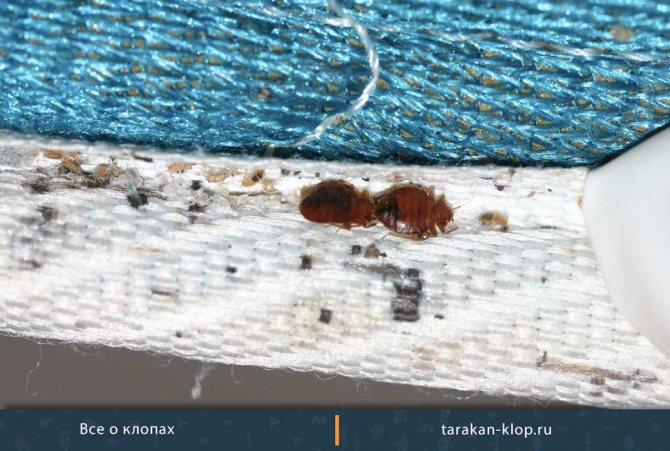

Many owners of private houses and apartments in multi-storey buildings face the invasion of bed bugs. Their presence does not mean that the owners are slovenly, they appear wherever there is a food source - people. Parasites are found when they have reached significant numbers. At first, a person tries to poison bedbugs on his own, but a series of unsuccessful attempts forces him to contact the sanitary service and carry out a professional treatment of the room.
Disinsection is a type of disinfection of a room, when insects are destroyed using chemical, biological agents, hot water with steam.
- 14.02.2018 5:45:03
- odor treatment
When do you need reprocessing?
Repeated pest control is needed if the area of pest localization has changed. And also resort to repeated procedure if:
Before carrying out pest control a second time, you should consult with a specialist who will tell you how many days you can repeat the procedure and explain why the bug has not died.
Cleaning the house after disinfection from bedbugs
What to do after treating the apartment from bedbugs?
- Leave the apartment for at least a couple of hours, ventilating the room until the smell of the insecticide disappears completely.The drugs are not toxic to humans and animals, but the smell will interfere with normal life.
- Wash the dishes well with cleaning agents.
- If, for some reason, food remains in the treated room, they must be thrown away.
- Wet cleaning is necessary on those surfaces that you use - tables, bedside tables, stools, doorknobs, and so on. In places where there is no danger of contact with the product (behind plinths, pipes, doorways), cleaning is carried out after the death of all insects or after the loss of the effectiveness of the product. The effectiveness of the treatment depends on how long the toxic substance remains on the surfaces.
- It is recommended to wash linen and clothes at a temperature of at least 50 degrees.
- 2-3 days after the treatment for bedbugs, brush the vacuum cleaner over the baseboards, upholstered furniture, gently vacuum the wallpaper in the upper part of the wall. Cleaning the apartment after disinfection will get rid of insect larvae and dead individuals. Shake the bag outside immediately.
In general, it will take a month to completely get rid of bedbugs, since the larvae appear after the pest control procedure. When, upon contact with the poison, they die, the activity to destroy the parasites can be considered complete.
In the event that the number of bedbugs is large enough, it is not always possible to remove them using chemicals. To solve the problem, it is better to resort to professional disinfection. However, to make cleaning the room after processing easier, before starting the procedure, you need to perform some steps:
- Remove all food and personal hygiene items from the room. This precaution is due to the fact that splashes of chemical solutions can get on them, and then everything will have to be thrown away.
- Provide free access to the sleeping area, as it is processed first.
The processing process itself will take a little time - about 1 hour. In order to avoid exposure to chemicals on the human body, you need to know what to do after processing the apartment. After disinfection, the hosts must leave their home for at least 2 hours. Returning home, you need to immediately open all the windows so that the apartment is properly ventilated.
Then you should collect the dead bugs, their eggs and larvae on a scoop, pour them into a garbage bag, which you immediately take out into the trash can or burn. You can also collect insects with a vacuum cleaner. Hand can only be collected with rubber gloves, which must then be discarded.
Wet cleaning should be done as late as possible. Therefore, it is recommended to go somewhere - to relatives, friends or to the country. This is due to the fact that living insects can remain in the room, which hide in secluded places. If you do not do wet cleaning, then they, moving along the treated surfaces, will also die after a while. it is worth returning to the apartment in 2 weeks.
After returning to the apartment, you should once again well ventilate it. Then you need to wash all bedding and clothes. In this case, the water temperature must be at least 90 ° C. For bedbugs, temperatures above 45 ° C are destructive, therefore, at 90 ° C, there will be no living insects. You need to wash pillows and blankets, as well as soft toys, if they are in the apartment.
The next step is a thorough wet cleaning of the room. It is necessary to wash all kitchen utensils well, treat furniture with hot water and an antiseptic. A soda solution can be used as an antiseptic. You can use soapy water. For its preparation, laundry soap is dissolved in warm water.
Particular attention should be paid to hard-to-reach places: vacuum and wipe down the baseboards and corners. In addition, it is advisable to use a vacuum cleaner on the upholstered furniture, in addition, on the wallpaper, but only the upper part of it.Ceiling and floor skirting boards should only be washed after 3-6 weeks.
When cleaning a room after disinfection, it is not recommended to touch those places with which a person practically does not contact.
A small amount of insecticide should remain in crevices and folds. In the future, this will serve as a good prevention against bedbugs.
If there are paintings or other decorative elements on the walls, they are also washed with soapy water. If there are carpets in the apartment, it is important to know that they need to be vacuumed both from the outside and from the inside. The cleaning of polished furniture and mirrors should be especially careful, as a white coating from the sprayed chemical remains on their surfaces.
If it happened that some products were forgotten to be removed from the home before disinfection, then after treatment from bedbugs they must be thrown away.
It will take about 1 month to completely destroy insects. The advantage of this procedure is that you do not need to re-treat the apartment from bedbugs.
Thus, faced with the problem of the presence of bedbugs in the apartment, it is necessary to approach the issue of getting rid of them with all responsibility. It is not only the stage of disinfection of the apartment that is important, but also the stage of its subsequent cleaning. It is necessary to find out how long it will take to destroy the insects. Observing all the rules for carrying out the procedures, you can get rid of bugs forever.
A clear idea of what to do after treating bedbugs and following the recommendations of the disinfector will help increase the effectiveness of sanitation and prevent chemical poisoning. We will figure out how to clean the apartment, how to treat the surface so that all the efforts spent do not disappear.
Algorithm for cleaning an apartment after etching bedbugs:
- Airing. Open all vents and windows. With an intense draft on the first day after returning, it is enough to air the room for 2-3 hours, if the air exchange is slowed down, it is better to leave the windows open for 5-6 hours. In the following days, airing should be repeated regularly to get rid of chemical odors.
- Postpone general cleaning. Sanitation in the first weeks after disinfection is moderate. After a cold fog or hot fog in the apartment, semi-living or dead parasites can be identified. They should be carefully swept into the scoop, but there is no need to mop the floor. The most contact points must be wiped with a damp cloth moistened with soapy water. These areas include: doorknobs, tables, chairs, switches.
- Wash. Wash bedding at 60 ° C. Do bed bugs survive after washing? The probability of their destruction during heat treatment is quite high, but the eggs of parasites are ways to survive. Therefore, the textiles must be ironed after washing - a hot iron will not leave a chance for bug offspring.
- Dishes. All plates, cups, kitchen utensils must be rinsed before use. This measure is necessary even if the dishes were packed in bags.
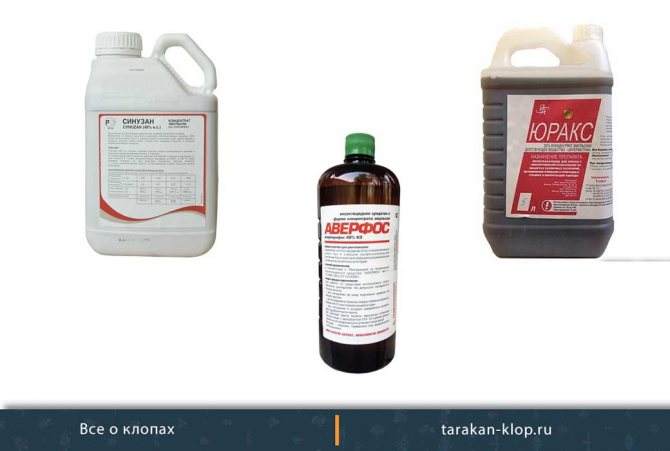

All of these activities are carried out before children and pets return to the apartment.
A full wet cleaning is performed after a month. If the bugs bite and periodically continue to climb out of shelters, then part of the population is still alive - you need to wait a little with the final cleaning of the insecticide.
Tags: disinfection, apartment, bug, after, clean up
About
«Previous post
Features of life
Bed bugs adapt very well to environmental conditions. Blood-sucking insects are quite difficult to remove from one go. It takes patience and the right approach to handling the room to make the bugs go away. Before proceeding with the procedure, you must familiarize yourself with the following facts:
- insects are able to move throughout the territory in search of a person;
- under the influence of low temperatures, bedbugs hibernate;
- high temperature is destructive for parasites, by washing clothes and linen at temperatures of 90 degrees and above, insects can be destroyed;
- the female bug lays from 300 to 500 eggs in her entire life;
- even in the absence of food, bugs can live for several months;
- high-quality processing does not guarantee instant disposal of parasites, bedbugs can live for another two to three weeks.
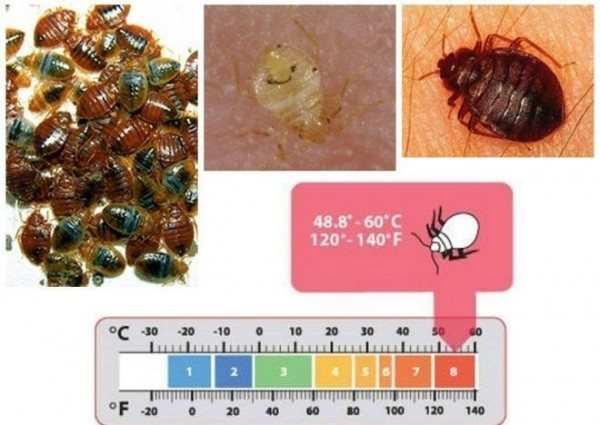

Bedbug death temperature
If insects do not have enough food, they can go into a state of suspended animation and stay for a year and a half, then wake up and start biting a person again.
All these factors explain the fact that bedbugs do not die immediately after pest control.
People tend to exaggerate the danger of most funds.
This means that in fact, most funds are less dangerous than they seem at first glance.
The fact is that people are generally lazy. And instead of really studying the effect of a particular agent, and even more so of its active substance on the human body, they prefer to be guided by common stereotypes that:
- Chemistry is dangerous;
- If the product poisons insects, it will also poison people;
- Industrial "chemicals" are more dangerous than folk remedies.
And usually, when making decisions, a person relies on such stereotypes unconsciously. Like, chemistry means bad. And the weed means good.


The problem here is that it is easier to put such a stamp "Dangerous" on any product than to remove bedbugs with such stamps. Confirmation of this is the grandmothers who categorically refuse pest control and industrial insecticides, for years "frighten" bedbugs with tansy and wormwood and breed thousands of these parasites at home. If you don't want to breed bedbugs like these grandmothers, change your stereotypes.
Why didn't the drugs work?
Although bed bugs are called bed bugs, they are smart enough to appear in bed only at night, from about 2 o'clock in the morning until dawn, when the sleeping person is guaranteed to be in deep sleep. The rest of the time bugs live and breed in secluded places. Here is a partial list:
- between structural elements of beds and sofas;
- behind paintings and framed photos;
- in dressers, wardrobes, on shelves, in drawers of tables;
- in mattresses, mattress toppers, pillows, covers, bedside rugs and even curtains;
- in animal cages, in cat and dog bedding and houses;
- in table lamps, lamps, sockets, under wallpaper, under panels, behind skirting boards, under parquet and laminate.
It makes no sense to list all the secluded places where bugs live (presumably) in your house. To discover their masonry and shelters, one has to imbue with the philosophy of an insect and figure out where it is most convenient to hide, and the shelter should not be far from the feeding trough - a sleeping person.
In advanced cases, bugs huddle everywhere, in all crevices, corners and beds. The fact is that at all stages of development, bugs and their nymph larvae move quite quickly and are able to overcome up to one and a half meters per minute. It costs nothing for insects to crawl the whole room in a quarter of an hour and get into a warm bed to suck their fill of human blood.
It is impossible to say with certainty whether the bugs will die after disinfection. Survival depends on many factors. If even the most secluded corners have been well treated, the chance of getting rid of parasites quickly increases.
The adults will disappear, but their newly emerged larvae will be alive. Parasites rarely disappear right away; it will take time. The newly appeared individuals will die after a while, since the effect of modern insecticides is long lasting. Do not rush and do general cleaning immediately after processing.
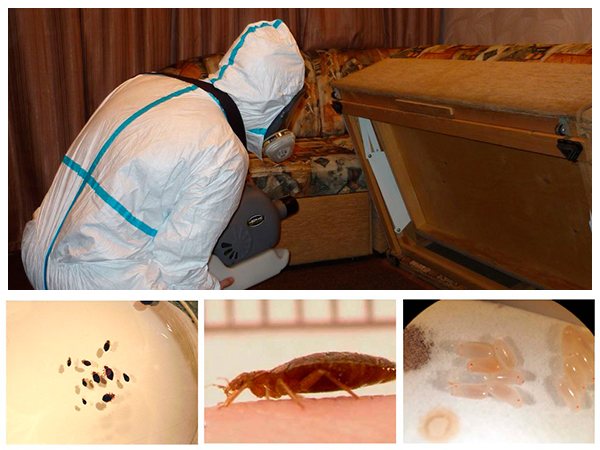

An improperly selected insecticide may not work. It is better to choose modern drugs, since insects have developed strong immunity to insecticides of the old generation.
It is important to identify the cause of the appearance of insects, as a rule, people bring them into the apartment, the bugs themselves cannot travel significant distances. It should be analyzed from where the parasites can be brought into the house, otherwise, after destruction, the insects will be brought in again and the infection will repeat.
It is not excluded that the bugs came from neighbors, in which case it is advisable to carry out the processing in all neighboring apartments.
To avoid re-infection, it is better to entrust the work to professional services.
The effectiveness of the procedure depends, as a rule, on what product was used. Pesticides are divided into several types:
- pyrethroids belong to the group of ineffective drugs;
- phosphroganic compounds affect adults and their larvae;
- neoncotinoids.
Insecticides begin to work after 30-40 minutes. The first batch of pests perishes in half an hour. At the same time, some individuals show resistance to the effects of insecticides. After three days, the rest of the parasites will die out.
Often, surviving insects change their location, a group of parasites leaves for a neighboring apartment or chooses a poorly treated place in the same apartment. To exclude a change in localization, processing should be carefully carried out in all corners of the room. With the right approach to the procedure, uninvited guests will disappear at once.
How many bugs live after treatment depends on many factors; it is impossible to give an unambiguous answer to the question. In order for the insects to go away, you should correctly approach the process of their removal.
Executioner
The active substance of the Executioner is fenthion, a compound from the organophosphorus group, the same one to which the aforementioned karbofos belongs. The drug acts on the human body in a similar way to drugs based on malathion: when significant amounts enter the respiratory or digestive tract, typical poisoning can develop, which quickly passes with adequate measures.
In the photo - 5 bottles of the Executioner, which are enough to destroy bedbugs in a one-room apartment:
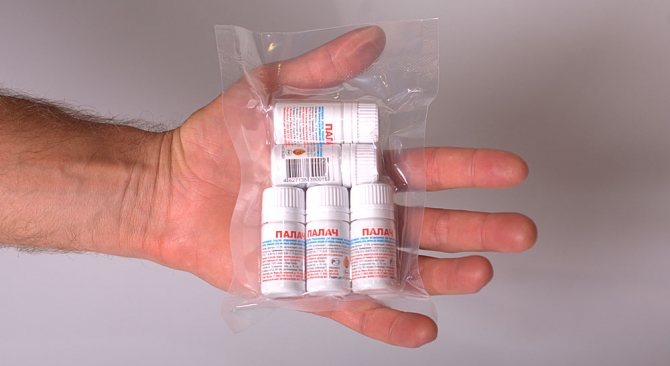

Cases of severe poisoning by the Executioner when used at home are not known. At a minimum, people do not drink it in glasses, and they cannot breathe for a long time because of its unpleasant smell. The instructions for use of the Executioner indicate that they can spray the premises only in a respirator, clothes with long sleeves and glasses. If these requirements are met, the likelihood of poisoning will be minimal.
Both in composition and in safety profile, the Executioner is similar to Forsyth. Both funds are considered one of the most powerful preparations for self-treatment of apartments.



